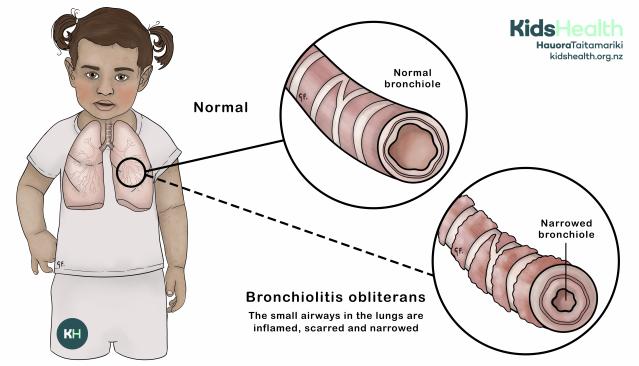Key points about bronchiolitis obliterans
- bronchiolitis obliterans (BO) happens when the small airways (bronchioles) in the lungs become scarred and narrowed
- it is very rare
- there are many causes
- there is no cure, but treatments can help manage the symptoms
- a small number of tamariki with bronchiolitis obliterans may need long-term oxygen therapy to help them breathe
For information on common viral bronchiolitis, see the bronchiolitis page.
What is bronchiolitis obliterans?
Bronchiolitis means inflammation in the small airways (bronchioles). Obliterans means gradual scarring and severe narrowing.
Bronchiolitis obliterans is a long-term lung condition. The scarring and narrowing can get worse over time. This makes it harder to breathe.

transcribeTranscript
The image shows a young girl with pigtails wearing a white outfit. Her chest area displays an illustration of the lungs, with a zoom-in on a small airway (bronchiole).
Two detailed insets compare:
- a 'Normal bronchiole' which shows a wide and open bronchiole
- a 'Narrowed bronchiole' which appears thickened and constricted
Text below reads: 'Bronchiolitis obliterans: The small airways in the lungs are inflamed, scarred and narrowed.'
The image is branded with the KidsHealth Hauora Taitamariki logo and website: kidshealth.org.nz.
Causes of bronchiolitis obliterans
Bronchiolitis obliterans most commonly happens after a severe viral lung infection.
Other causes of bronchiolitis obliterans include:
- severe acid reflux that causes food or liquid to go into the lungs (aspiration)
- breathing in harmful substances, like fire smoke or chemical fumes
- a bone marrow or heart-lung transplant
- Stevens-Johnson Syndrome (a very rare reaction to an infection or medicine)
Your health professional may not be able to tell you what has caused your child to have bronchiolitis obliterans.
How common is bronchiolitis obliterans?
Bronchiolitis obliterans is extremely rare. In Aotearoa New Zealand, there are likely fewer than 200 tamariki with this condition across the whole country.
Signs and symptoms of bronchiolitis obliterans
Bronchiolitis obliterans affects the small airways in the lungs, the bronchioles. This makes it harder to breathe.
Tamariki and rangatahi (young people) with bronchiolitis obliterans may have:
- wheezing (a type of noisy breathing) even when they are completely well
- a long-lasting wet cough that is always there
- trouble breathing, especially during exercise or play
- low oxygen levels at night
Diagnosing bronchiolitis obliterans
The symptoms of bronchiolitis obliterans are similar to other lung conditions. If your child’s health professional thinks they have bronchiolitis obliterans, they will order a CT scan of your child's chest. A CT scan can give a detailed picture of your child’s lungs and can show any scarring or narrowing of the airways.
Bronchiolitis obliterans may not be diagnosed until months or even years after it has happened. This is because it can take a long time for the symptoms to properly show.
Managing bronchiolitis obliterans
There is no cure for bronchiolitis obliterans. However, treatment can help improve symptoms and reduce problems over time.
Asthma inhalers
Sometimes, asthma inhalers can help ease symptoms of bronchiolitis obliterans. Asthma inhalers do not stop the underlying scarring of the lungs.
Oxygen therapy
Some tamariki may need oxygen therapy to help improve their symptoms.
Medicines
Tamariki who developed bronchiolitis obliterans after a bone marrow transplant might receive special medicines. These medicines don’t work for other causes of bronchiolitis obliterans.
Keeping well
Bronchiolitis obliterans can sometimes lead to a condition called bronchiectasis. Bronchiectasis is permanent damage to the larger airways and can happen if chest infections keep coming back. Health professionals will try to prevent your child from getting bronchiectasis.
What to expect with bronchiolitis obliterans long term
It’s hard to predict how bronchiolitis obliterans will affect each child. Some tamariki stay stable, while others may get worse over time.
If the scarring gets worse, it can lead to more infections and further lung damage. In very rare cases, the lung damage is so severe that a lung transplant may be discussed. If this happens, health professionals will guide and support you and your whānau (family) through the process.
Keeping your child with bronchiolitis obliterans well
There are several important ways parents can support their child with bronchiolitis obliterans.
Smoke-free and vape-free environment
Keep your child’s environment smoke-free and vape-free. If you want to give up smoking or vaping, contact Quitline or talk with your health professional or whānau.

If you want to give up smoking or vaping call Quitline free on 0800 778 778. Quitline can provide free support and advice to help you or someone in your whānau quit smoking. Visit their website for more information.
Vaccinations
Keep your child’s routine vaccinations up to date. Your child should also get the flu vaccine every year.
Extra vaccines may be needed depending on the season - your child’s lung specialist will discuss this with you.
Keeping your home warm and dry
Keeping your home warm and dry over winter helps keep your whānau healthy.
